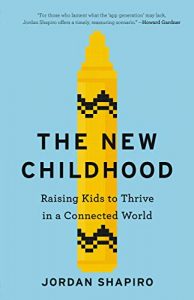
I must confess, I’d never given much thought to the origin of sandboxes. I played in them, my kids play in them, and so I just assumed that children have been building crumbling castles and holes to China since time immemorial. After reading Jordan Shapiro’s The New Childhood: Raising Kids To Thrive in a Connected World, I now have a newfound appreciation for the history and social impact of the playground mainstay.
Originally called sand-piles, sandboxes debuted in German public parks in the 1850s as part of the kindergarten movement, and hit US shores about 40 years later. The idea of devoting a space to free and natural play was a tough sell for parents who thought of their kids as junior laborers. “It represented radical economic, social, and cultural change,” writes Shapiro. Anxious parents then didn’t see that sandbox play was a type of preparation for the industrial economy, much like parents today struggle to validate digital play. According to Shapiro, our kids are not withdrawing into their screens, but extending into the world. The grains of sand have become pixels and when kids build Minecraft castles with a friend Skyped-in from China, they’re prepping for participation in a connected global economy. Our job as parents, then, is not to prohibit, but to guide and support them on their journey.

If your parental screen anxieties are not completely allayed, don’t worry: the sandbox backstory is just start. Shapiro teaches humanities at Temple University, and he lectures, writes, and advises globally on an extensive array of topics. And, like our favorite professors, he is erudite, but always accessible and engaging. He curates a menagerie of pastimes and rituals that we associate with timeless family values and exposes them as products of recent technology, media, and socio-economic forces. Family dinner? An invention of the Victorians. Handwriting? Most people couldn’t write for most of history. He makes his case for the links between technology, social change, and family values by plucking from Greek philosophy, literature, video games, media theory, finger painting, word origins, developmental theories of play, fairytale scholarship, and the history of photography. The New Childhood converges a ranging network of interesting historical curiosities and psycho-social theories to advance its thesis: rather than restrain kids with outdated practices, parents are invited to adjust and meet the demands of the Digital Age.
Each chapter delves into a different facet of childhood, including playtime, bedtime stories, family life, puberty, and school. A common thread that emerges is that connected culture erodes the boundaries that have traditionally separated the public from the private, global from local, home from work, and school from play. The collapse of these divisions means that, socially and culturally, the lines are being redrawn and we are left to figure out how to best orient our kids in unfamiliar territory. New protocols, rituals, and etiquettes must be formulated to help the next generation prosper in an economic reality that promises to be substantially different from what we are used to.
But what does this mean in practical terms?
Shapiro urges that we take some of the sacred cows of family life out to pasture: “The family traditions that we take for granted exist to cultivate children into well-adjusted adults who can easily participate in a specific kind of society. These customs are neither sacred nor essential to the human experience. It’s all just fashion; and fashion changes over time.” When the historical lens widens, social customs and practices are exposed as provisional, whether it’s the way we parcel time in schools or how children play. What remains unchanged, however, is the family’s role as a secure foundation which Shapiro symbolically connects to the hearth: “The hearth is what provides us with a sense of stability. It anchors us to something greater than the individual self. It provides a thread that roots us to a shared past.”
The book advocates for parents to “coview”, or make time to share and discuss media with kids —a core practice for both media and digital literacy. “Parents need to introduce their children to digital social spaces early and with clear intention,” he writes. “Expose them to online behaviour that aligns with your values. Do it sooner rather than later. Do it when they are young and still enjoy interacting with adults. Connect them to safe communities that model mature etiquette.” Even spending time together on separate devices is a kind of parallel play that involves a subtle form of socialization.
Shapiro’s writing itself embodies the hybridization characteristic of modern life. His book is an information network that spans history and the globe, but it is also rooted in anecdotes about the intimacies of his own family life. The wellspring of his position is largely nourished by the struggles and successes he’s experienced while striving to strike a healthy approach to technology with his preteen sons. He observes that his kids’ digital consumption is characterized by impermanence, and that “kids are rarely exposed to durable symbols, artifacts, or stories.” Whatever our emerging family rituals look like, they should aim to not only cultivate appropriate values, but also to provide a centering and stable haven from which kids can venture into the virtual yonder.
Despite the title, what The New Childhood really calls for is a new parent or, more precisely, new parenting. It’s a primer for the unfamiliar landscape of the connected world, and it invites us to resist our technophobic urges and to look at our life with fresh eyes, unfettered by the often irrelevant expectations of our immediate past. It not only signals an irreversible shift in family dynamics, but also lets the reader into the secret histories of everyday objects and rituals. Whether you agree with all of Shapiro’s views or not, The New Childhood is an entertaining read that will leave you a better informed parent and a more knowledgeable human being.
 Paul Darvasi is an educator, writer, speaker, and game designer whose work looks at the intersection of games, culture and learning. He teaches English and media studies in Toronto, Canada and is a doctoral candidate at York University. His research explores how commercial video games can be used as texts for critical analysis by adolescents. He has designed pervasive games that include The Ward Game, based on Ken Kesey’s One Flew Over the Cuckoo’s Nest, and Blind Protocol, a cyber warfare simulation that instructs on online security, privacy and surveillance. Paul has worked with the US Department of Education, UNESCO, foundry10, Consumers International, iThrive, and Connected Camps and has participated in several international research projects. He recently wrote a working paper for UNESCO on how commercial video games can be used for peace education and conflict resolution. Paul’s work has been featured on PBS, NPR, CBC, the Huffington Post, Polygon, Killscreen, Gamasutra, Sterne, Endgadget, Edutopia, and MindShift.
Paul Darvasi is an educator, writer, speaker, and game designer whose work looks at the intersection of games, culture and learning. He teaches English and media studies in Toronto, Canada and is a doctoral candidate at York University. His research explores how commercial video games can be used as texts for critical analysis by adolescents. He has designed pervasive games that include The Ward Game, based on Ken Kesey’s One Flew Over the Cuckoo’s Nest, and Blind Protocol, a cyber warfare simulation that instructs on online security, privacy and surveillance. Paul has worked with the US Department of Education, UNESCO, foundry10, Consumers International, iThrive, and Connected Camps and has participated in several international research projects. He recently wrote a working paper for UNESCO on how commercial video games can be used for peace education and conflict resolution. Paul’s work has been featured on PBS, NPR, CBC, the Huffington Post, Polygon, Killscreen, Gamasutra, Sterne, Endgadget, Edutopia, and MindShift.

